What Is the Process of Changing the Appearance of a Paragraph of Text Called
The default LaTeX formatting is fine and makes documents quite readable, but it can be changed if you need a different looking document. This article explains how to change the paragraph and line spacing.
Introduction
Changing the length of some specific elements may alter the look of the entire document.
\documentclass {article} \usepackage [utf8] {inputenc} \usepackage [english] {babel} \setlength { \parindent }{4em} \setlength { \parskip }{1em} \renewcommand { \baselinestretch }{2.0} \begin {document} This is the first paragraph, contains some text to test the paragraph interlining, paragraph indentation and some other features. Also, is easy to see how new paragraphs are defined by simply entering a double blank space. Hello, here is some text without a meaning. This text should show what a printed text will look like at this... \end {document}
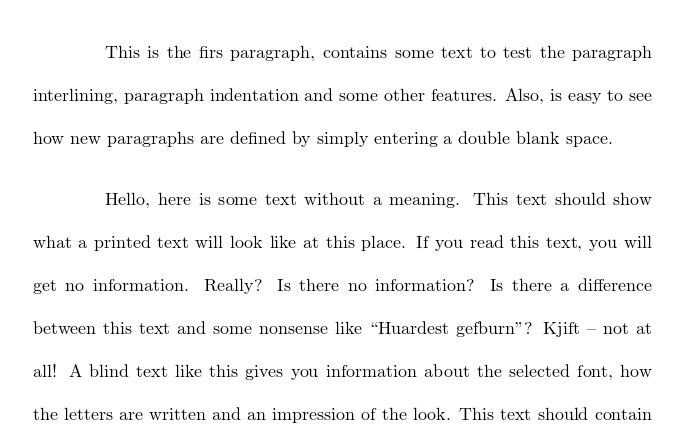
In the previous example paragraphs are separated by a blank line in between them, this is quite easy and convenient. In this example the indentation at the first line of a paragraph, the line spacing and the paragraph spacing are manually set. These latter commands will be explained in more detail throughout the next sections.
Open an example in Overleaf
Starting a new paragraph
To start a new paragraph in LaTeX, as said before, you must leave a blank line in between. There's another way to start a new paragraph, look at the following snippet.
This is the text in first paragraph. This is the text in first paragraph. This is the text in first paragraph. \par This is the text in second paragraph. This is the text in second paragraph. This is the text in second paragraph. ![]()
As you can see, the \par command starts a new paragraph without the need of a blank line.
Open an example in Overleaf
Paragraph Indentation
By default, LaTeX does not indent the first paragraph of a section or a chapter. The size of the subsequent paragraph indents is determined by \parindent
\setlength { \parindent }{4em} \begin {document} This is the text in first paragraph. This is the text in first paragraph. This is the text in first paragraph. \par This is the text in second paragraph. This is the text in second paragraph. This is the text in second paragraph. This is another paragraph, contains some text to test the paragraph interlining, paragraph indentation and some other features. Also, is easy to see how new paragraphs are defined by simply entering a double blank space. ... \end {document}
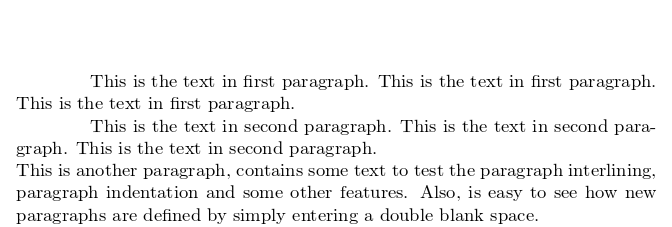
The default length of this parameter is set by the document class used. It is possible to change the indent size. In the example, the first lines of each paragraph are indented 4em (an "em" equals the length of the "m" in the current font), this is accomplished by the command \setlength{\parindent}{4em}. It's recommended to put this command in the preamble of the document, but it can be set anywhere else.
If you want to create a non-indented paragraph, like the second one in the example, put the command \noindent at the beginning of it. If you want the whole document not to be indented, set the indentation length to zero with \setlength{\parindent}{0pt}.
On the other side, if you want to indent a paragraph that is not indented you can use \indent right above it. It should be noted that this command will only have an effect when \parindent is set to zero.
Open an example in Overleaf
Paragraph spacing
The length parameter that characterises the paragraph spacing is \parskip, this determines the space between a paragraph and the preceding text.
\documentclass {article} \usepackage [utf8] {inputenc} \usepackage [english] {babel} \setlength { \parindent }{4em} \setlength { \parskip }{1em} \begin {document} This is the text in first paragraph. This is the text in first paragraph. This is the text in first paragraph. \par This is the text in second paragraph... \end {document}
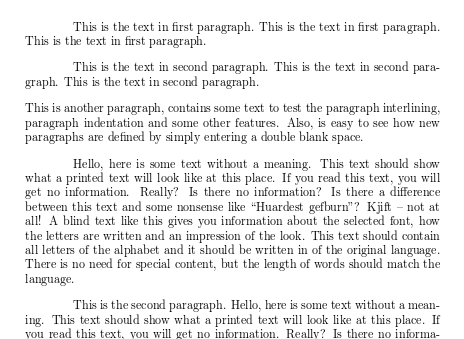
In the example, the command \setlength{\parskip}{1em} sets the paragraph separation to 1em.
Open an example in Overleaf
Line spacing
There are three commands that control the line spacing, below is an example redefining the length of \baselinestretch
\documentclass {article} \usepackage [utf8] {inputenc} \usepackage [english] {babel} \setlength { \parindent }{4em} \setlength { \parskip }{1em} \renewcommand { \baselinestretch }{1.5} \begin {document} This is the text in first paragraph. This is the text in first paragraph. This is the text in first paragraph. \par This is the text in second paragraph... \end {document}
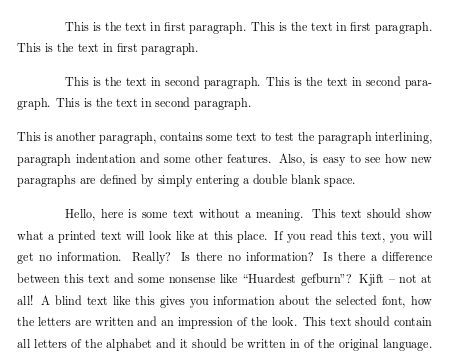
In the example above, \renewcommand{\baselinestretch}{1.5} scales the default interline space to 1.5 its default value. Of course that number can be set to any value.
As mentioned before, there are other two LaTeX lengths that may change the line spacing:
-
\baselineskip - Is a length determining the minimum space between the bottom of two successive lines in a paragraph; it may be changed (in the preamble) by
\setlength{\baselineskip}{value}. Where value is set using any of the LaTeX units.
-
\linespread{value} - where value determine line spacing. This value is somewhat confusing, because:
| Value | Line spacing |
|---|---|
| 1.0 | single spacing |
| 1.3 | one-and-a-half spacing |
| 1.6 | double spacing |
Open an example in Overleaf
Reference guide
Schematic presentation of lengths in a paragraph
- \parindent, determining paragraph indentation
- \parskip, determining space between paragraph and preceeding text
Further reading
For more information see:
- Lengths in LaTeX
- Line breaks and blank spaces
- Text alignment
- Multiple columns
- Paragraphs and new lines
- Bold, italics and underlining
- Font sizes, families, and styles
- Font typefaces
- Supporting modern fonts with XƎLaTeX
- Lists
- Sections and chapters
- Management in a large project
- The not so short introduction to LaTeX2 ε
What Is the Process of Changing the Appearance of a Paragraph of Text Called
Source: https://www.overleaf.com/learn/latex/Paragraph_formatting
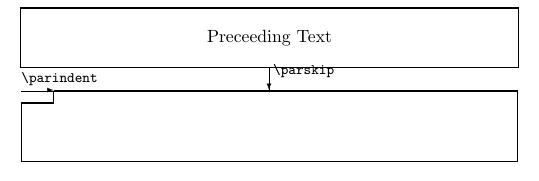
Enregistrer un commentaire for "What Is the Process of Changing the Appearance of a Paragraph of Text Called"